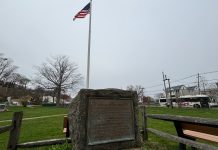AT MONMOUTH PARK, it starts here. For some 700 races this season, the horses won’t leave the gate until John Daniels (known at the track as JD) says so. And if you think it’s just pushing a button to release the spring loaded gate’s front barrier, think again … It’s a lot more complicated.
Daniels has been around horses since he was a teen and after college and military service has been working thoroughbred tracks for 50 years. He has been at Monmouth since 1987 and became the official starter in 2013.
But Daniels doesn’t do it alone. Working with him are a group of assistant starters who climb around the 1940s era starting gate like kids on a jungle gym. “Horses aren’t comfortable being confined on four sides in the gate,” Daniels says, “and getting them all quiet and standing still for a fair start takes a team.”
Today, a thoroughbred race is a carefully orchestrated event. Start times for races are posted and adhered to. Races vary in length and the huge 1940s era gate, capable of holding 12 horses, has to be moved and repositioned around the track. A second gate is used for turf races and sits on the track’s infield and is available as a back-up if needed.
The starting gate can be scary for horses and starting staff, trainers and jockeys want to be sure thoroughbreds can enter the gate, stand for several seconds or longer until the field is set for the start. A thoroughbred’s gate personality is critical for the horses as well as the assistant starters safety.
Trainers bring their young horses to the starting gate often to get them use to the loading and starting procedures.
Thoroughbreds do not race until they have been certified race ready at the starting gate by Daniels and his staff. Gate school runs each morning while the track is open for workouts.
Each of Monmouth’s thoroughbreds is tracked by Daniels and his staff. Jim Homewood handles the book for Daniels and each thoroughbred is listed with his or her idiosyncrasies and tendencies. “We have to know what to expect on race day when we may have close to a dozen 1200-pound plus, high strung thoroughbreds in the gate,” he says.
“Standing,” an exercise rider, sitting on a two-year old filly, may call as his mount looks at the gate for the first time from 20 feet away. Daniels and the crew lead and coax the filly into the gate quietly where she stands for 30 seconds before being backed out. “OK,” Daniels says, “but it will take several more lessons before she is ready to race.”
“Busting out,” can be the call from another rider as his more experienced colt stands in the gate. When the track is clear, Daniels will open the front barrier manually or electronically as the rider urges his horse forward into a racing stride.
At the end of a two hour session, Daniels confers with Homewood and the book is updated for another day as assistant starters hustle off to other jobs at the track or on race days take a few hour break before they’re ready for show time.
Although Daniels, Rick Lewis, his senior assistant starter, and the other assistants don’t talk much about the risks, it is understood this is a dangerous job. The crew wears safety vests and at some tracks – helmets. Daniels is alert to possible danger and encourages his staff to be vigilant. “This isn’t for the faint of heart,” he says, “as horses can resist entering the gate, rear up and fall – sometimes taking a rider or one of my crew with them.”
The starting staff has strong hands, excellent reflexes and horse sense. Like pro athletes they work through bumps and bruises but it isn’t by chance that an ambulance and EMS personnel are stationed at the starting gate on both training and race days.
On race day, there’s a little more tension in the air as the crew knows it has to be perfect every race. “Tied down,” Daniels will yell, with his finger on the starting button as he looks to see that all riders and horses are set to go.
“One to load,” an assistant starter might answer as a colleague leads the last horse and rider into the chute. “All in” comes the call from the back of the gate. Jockeys’ tense and assistant starters keep a light hand on thoroughbred bridles to keep them still.
The gate opens with a loud bell. Horses jump forward onto the track and maneuver for position. “They’re off” booms the announcer and spectators follow the horses as they fly by Daniels who is standing on the rail about 30 feet down the track. The horses disappear down the track as jockeys urge them up to speeds approaching 40 mph.
Immediately the crew scrambles to move the gate off the track and the starting crew throws their leather, horse leads over their neck and hop on an open shuttle truck to be driven to the other side of the track for the next race just 20 minutes away.
It’s another day in the trenches for the starting crew and hopefully one with no excitement other than the adrenaline rush of watching jockeys and thoroughbreds disappear in a cloud of dust.
Story and photos by Art Petrosemolo














